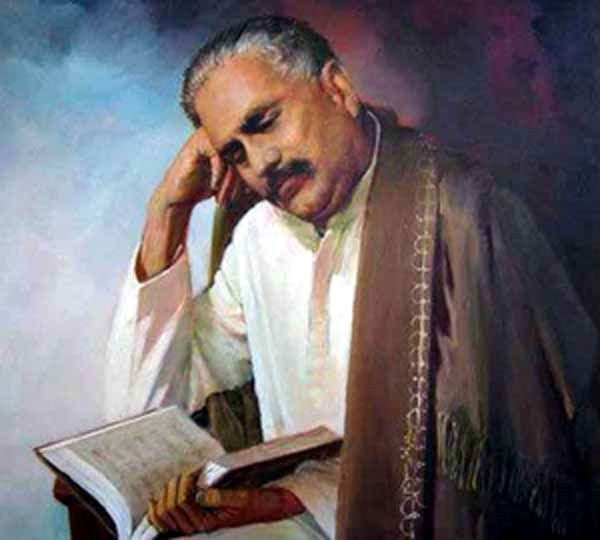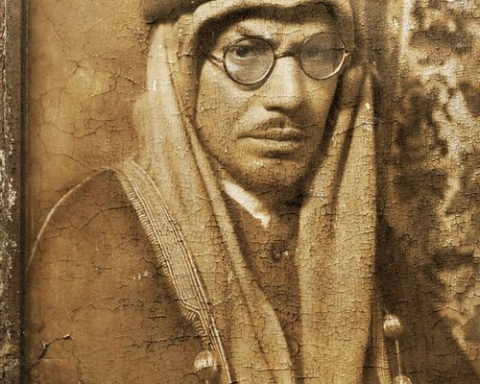“Rooh” is that divine spark which is present in every human being

Sir Muhammad Iqbal, or widely known as Allama Iqbal, was born on 9 November 1877 and died in 21 April 1938. He is regarded by many as one of the most influential Muslim figures in the 21st century. Only handful of Muslim poet, philosopher, academic, and scholarcould reach his status and became a “spiritual father” of a newborn nation-state, namely Pakistan. His literary works, in both Urdu and Persian, are considered by Indians, Pakistanis, and Iranians alike as important legacy in Islamic literature.
King George V honored Iqbal with the Knight Bachelor in 1922. While studying law and philosophy in England, Iqbal became a member of the London branch of the All-India Muslim League. Later, during the League’s December 1930 session, he delivered his most famous presidential speech known as the Allahabad Address in which he pushed for the creation of a Muslim state in north-west India.
Iqbal undoubtedly is an eminent poet. His first poetry book, The Secrets of the Self (Asrar-e Khudi), appeared in the Persian language in 1915. Well-known orientalist, R.A. Nicholson, who translated the work, says that it caught the attention of young Muslims as soon as it was printed. In this book, Iqbal explained his philosophy of “Self,” as synonymous to the word of “Rooh” in the Quran. “Rooh” is that divine spark which is present in every human being and was present in Adam for which God ordered all angels to prostrate in front of Adam.
However, according to him, one has to make a great journey of transformation to realize that divine spark. He then illustrates that transformation to the transformation of seed into fragrance. Every seed has the potential of fragrance within it. But to reach its actual fragrance, the seed must go through all the different stages of transformation. First by breaking out of its shell. Then breaking the ground to come into the light developing roots at the same time. Then fighting against the elements to develop leaves and flowers. Finally reaching its pinnacle by attaining the fragrance that was hidden within it.
Iqbal’s second book of poetry, The Secrets of Selflessness (Rumuz-e Bekhudi), also in Persian and published in 1918, completed his first book by tackling the main themes of ideal community, Islamic ethical and social principles, and the relationship between the individual and the society. Although he is true throughout to Islam, Iqbal recognizes the positive analogous aspects of other religions in this context. Iqbal sees the individual and his community as reflections of each other.
The individual needs to be strengthened before he can be integrated into the community, whose development in turn depends on the preservation of the communal ego. It is through contact with others that an ego learns to accept the limitations of its own freedom and the meaning of love. Muslim communities must ensure order in life and must therefore preserve their communal tradition. It is in this context that Iqbal sees the vital role of women, who as mothers are directly responsible for inculcating values in their children.
Iqbal’s other books of poetry include Message from the East and Persian Psalms. Amongst these, his best-known Urdu works are The Call of the Marching Bell, Gabriel’s Wing, The Rod of Moses and a part of Gift from Hijaz. Along with his Urdu and Persian poetry, Iqbal also produced many Urdu and English lectures and letters which has very influential impact in cultural, social, religious, and political discourses in much of South Asia and the Urdu-speaking world.
According to some scholars, Iqbal’s most daring and controversial work was none other than The Reconstruction of Religious Thought in Islam. It is a compilation of enchanting lectures on Islamic philosophy which was published in 1930. These lectures were delivered in Madras, Hyderabad, and Aligarh. The last chapter, “Is Religion Possible”, was added to the book from the 1934 Oxford Edition onwards. It was a book that made Iqbal a universal figure and has been translated into many languages, including Indonesia. Gunawan Mohamad, Taufiq Ismail, and Ali Audah undertook the translation into Bahasa in the late 1960s. On 2016, Mizan Publishing Group has republished the new translation of The Reconstruction based on its revised edition with annotation from M Saeed Sheikh.
We may characterize the Reconstruction as Iqbal’s response to “the problem of modernity”. Historically and intellectually, Iqbal lived in a changing world of Islam. This world was changing due to some internal factors, but also, not less importantly, to its direct contact – and clash, at some points – with the modern civilization, the most significant characteristics of which are science and technology. “The problem of modernity” above refers to the results of this contact.
In his Reconstruction Iqbal explicitly mentions his program of reconstruction several times, in different contexts. The first is in the preface when he states an urgent demand for “a scientific form of religious knowledge”, which he sees as natural in the absence of a method to experience religion as a living, inner experience, on which religious faith ultimately rests. (MK)
Continue to:
Notes:
The parts on Iqbal’s Reconstruction in this article is mainly based on Iqbal’s Method of Reconstruction by Zainal Abidin M. Baqir, published in Iqbal Review, Special Edition, October 1996 and will be republished in this website later on.




